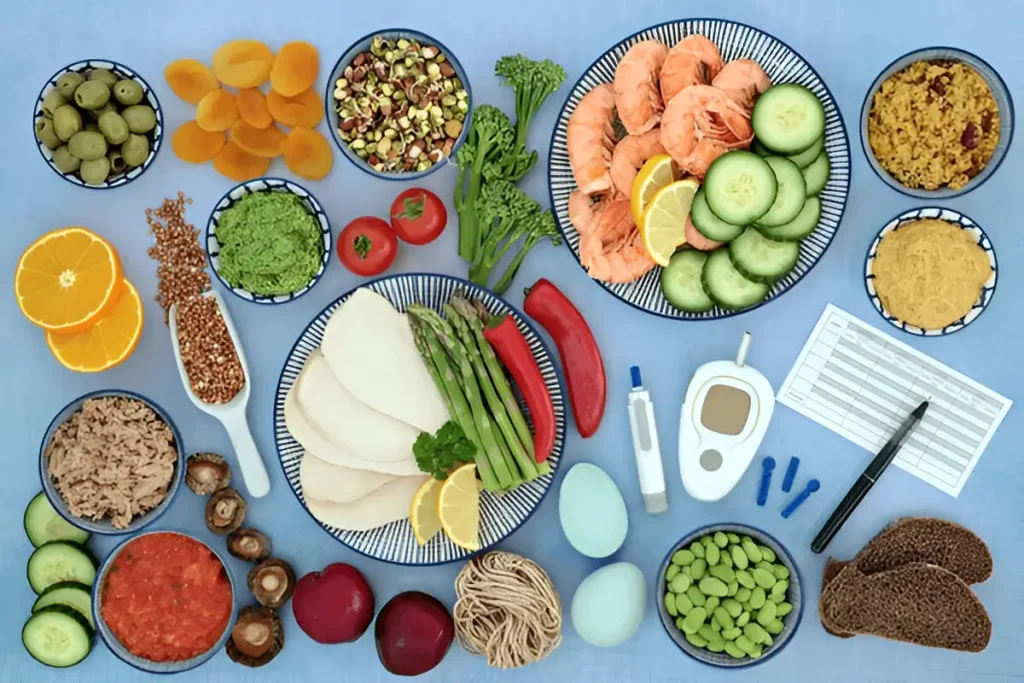7-Day Diabetic Diet Chart for Better Blood Sugar Control
Managing blood sugar levels is crucial for individuals living with diabetes. A well-structured meal plan can make a significant difference in maintaining healthy blood sugar levels. By following a best diabetic diet plan, you can better control your condition and improve your overall well-being.
A 7-day meal plan provides a clear outline of what to eat and when, helping you make informed food choices. This approach not only aids in blood sugar control but also promotes a balanced lifestyle. In this article, we will explore the benefits of using a diabetic diet chart and provide guidance on how to implement it effectively.
Table of Contents
Understanding Diabetes and Nutrition Connection
Managing diabetes effectively requires a deep understanding of how nutrition impacts your blood sugar levels. The food you eat plays a significant role in controlling your glucose levels, and making informed dietary choices is crucial for maintaining overall health.
How Food Affects Blood Sugar Levels
The impact of food on blood sugar levels varies depending on the type of food consumed. Foods high in simple carbohydrates, such as sugary snacks and refined grains, can cause a rapid spike in blood glucose. On the other hand, complex carbohydrates like whole grains, fruits, and vegetables are digested more slowly, resulting in a gradual increase in blood sugar. Understanding the glycemic index of foods can help you make better choices.
| Food Type | Effect on Blood Sugar |
|---|---|
| Simple Carbohydrates | Rapid increase |
| Complex Carbohydrates | Gradual increase |
| Protein and Healthy Fats | Minimal immediate impact |
The Importance of Consistent Meal Planning
Consistent meal planning is vital for managing diabetes. By planning your meals, you can ensure that you’re consuming a balanced diet that helps maintain stable blood glucose levels. A well-structured meal plan can also help prevent diabetes-related complications. A diabetic meal plan should take into account the nutritional value of foods, portion control, and the timing of meals.
By understanding how different foods affect your blood sugar and maintaining a consistent meal plan, you can better manage your diabetes and improve your overall quality of life.
Key Principles of a Diabetic Diet Chart
To manage diabetes effectively, it’s essential to understand the key principles that guide the creation of a diabetic diet chart. A well-crafted diet chart helps maintain blood sugar stability, which is crucial for overall health. The key principles focus on balancing macronutrients, understanding glycemic index and load, and implementing effective portion control strategies.
Balancing Macronutrients for Blood Sugar Stability
Balancing carbohydrates, proteins, and fats is vital for maintaining blood sugar stability. Carbohydrates have the most significant impact on blood sugar levels, so choosing complex carbs like whole grains, fruits, and vegetables is recommended. Proteins help regulate blood sugar and provide satiety, while healthy fats support heart health. A balanced meal should include a mix of these macronutrients to ensure stable blood sugar levels.
Glycemic Index and Load Considerations
Understanding the glycemic index (GI) and glycemic load (GL) can help you make informed food choices. The GI measures how quickly a food raises blood sugar, while the GL takes into account the serving size. Foods with a low GI and GL, such as whole grains and non-starchy vegetables, are ideal for maintaining blood sugar stability. Incorporating these foods into your diet can help manage diabetes more effectively.
Portion Control Strategies
Effective portion control is critical for managing blood sugar levels. Using measuring cups and a food scale can help you gauge your food portions accurately. Additionally, eating regularly spaced meals and snacks can prevent extreme hunger and overeating. A sample portion control guide is provided in the table below:
| Food Group | Recommended Serving Size | Examples |
|---|---|---|
| Vegetables | 1 cup raw or 1/2 cup cooked | Broccoli, spinach, bell peppers |
| Fruits | 1 medium fruit or 1/2 cup fresh/frozen | Apples, bananas, berries |
| Proteins | 3-4 ounces cooked | Chicken, fish, tofu |
| Grains | 1 slice whole grain bread or 1/2 cup cooked brown rice | Brown rice, quinoa, whole wheat bread |
Essential Nutrients for Diabetic Health

Understanding the essential nutrients for diabetic health can significantly impact your ability to manage the condition. A diet rich in the right nutrients helps maintain healthy blood sugar levels, supports overall health, and reduces the risk of diabetes-related complications.
Fiber-Rich Foods and Their Benefits
Fiber-rich foods are particularly beneficial for diabetics. They help slow down the digestion of carbohydrates, reducing the impact on blood sugar levels. Include foods like legumes, oats, and a variety of fruits and vegetables in your diet. These foods not only provide fiber but are also rich in vitamins, minerals, and antioxidants.
Healthy Fats Selection
Not all fats are created equal. For diabetics, choosing healthy fats is crucial. Monounsaturated and polyunsaturated fats, found in foods like avocados, nuts, and olive oil, can help lower cholesterol levels and improve heart health. Avoid saturated and trans fats, which can increase the risk of heart disease.
Protein Sources for Diabetics
Protein is an essential nutrient that can help regulate blood sugar levels. Good protein sources for diabetics include lean meats, fish, eggs, tofu, and legumes. These foods provide the necessary building blocks for the body without causing a significant spike in blood glucose levels.
Foods to Embrace and Limit on Your Diabetic Diet

When it comes to managing diabetes, the right food choices can make a significant difference in your overall well-being. A well-structured diabetic diet chart helps in maintaining blood sugar levels within the target range. Effective diabetic meal prep involves understanding which foods to include and limit in your diet.
Diabetes-Friendly Superfoods
Incorporating the right superfoods into your diet can significantly impact your blood sugar control. These foods are rich in nutrients, fiber, and antioxidants, making them ideal for a diabetic diet.
Non-Starchy Vegetables
Non-starchy vegetables like broccoli, spinach, and bell peppers are low in carbohydrates and rich in fiber and vitamins, making them an excellent choice.
Low-Glycemic Fruits
Fruits such as berries, apples, and pears are low on the glycemic index and won’t cause a significant spike in blood sugar levels.
Whole Grains and Legumes
Whole grains like quinoa and brown rice, along with legumes such as lentils and chickpeas, are rich in fiber and protein, helping to regulate blood sugar.
| Food Category | Examples | Benefits |
|---|---|---|
| Non-Starchy Vegetables | Broccoli, Spinach, Bell Peppers | Low in carbs, rich in fiber and vitamins |
| Low-Glycemic Fruits | Berries, Apples, Pears | Low glycemic index, rich in antioxidants |
| Whole Grains and Legumes | Quinoa, Brown Rice, Lentils, Chickpeas | High in fiber and protein, regulates blood sugar |
Foods to Moderate or Avoid
Some foods can negatively impact blood sugar control and overall health. It’s essential to limit or avoid foods high in added sugars, refined carbohydrates, and unhealthy fats.
- Sugary drinks and foods high in added sugars
- Refined grains like white bread and sugary cereals
- Foods high in saturated and trans fats
Smart Substitutions for Favorite Dishes
Making smart substitutions in your favorite recipes can make them more diabetes-friendly without sacrificing flavor. For example, you can replace white rice with brown rice or quinoa, and choose whole grain pasta instead of regular pasta.
By making informed food choices and incorporating diabetes-friendly superfoods into your diabetic meal prep, you can better manage your blood sugar levels and improve your overall health.
Complete 7-Day Diabetic Diet Chart for Blood Sugar Management

To help you manage diabetes, we’ve put together a comprehensive 7-day diet chart that includes balanced and nutritious meals. This meal plan is designed to provide you with the right foods to help control your blood sugar levels and maintain overall health.
Day 1: Getting Started with Balanced Meals
Starting your diabetic diet chart with balanced meals is crucial. Begin with a breakfast that includes oatmeal with fruits and nuts, providing a good mix of carbohydrates, fiber, and healthy fats.
Breakfast, Lunch, Dinner, and Snacks
For Day 1, consider the following meal plan: – Breakfast: Oatmeal with fruits and nuts – Lunch: Grilled chicken breast with quinoa and steamed vegetables – Dinner: Baked salmon with brown rice and mixed greens salad – Snacks: Carrot sticks with hummus and a handful of almonds
Day 2: Incorporating More Vegetables
Increasing your vegetable intake is a key aspect of a diabetic diet. On Day 2, focus on adding a variety of colorful vegetables to your meals.
Breakfast, Lunch, Dinner, and Snacks
For Day 2, consider: – Breakfast: Scrambled eggs with spinach and whole-grain toast – Lunch: Vegetable stir-fry with tofu and brown rice – Dinner: Grilled turkey breast with roasted vegetables and quinoa – Snacks: Cucumber slices with guacamole and cherry tomatoes
Day 3: Healthy Protein Options
Including healthy protein sources in your diet is vital for managing diabetes. Day 3 focuses on incorporating lean proteins into your meals.
Breakfast, Lunch, Dinner, and Snacks
For Day 3, consider: – Breakfast: Greek yogurt with berries and walnuts – Lunch: Grilled chicken Caesar salad – Dinner: Baked cod with sweet potato and green beans – Snacks: Hard-boiled eggs and a small apple
Day 4: Smart Carbohydrate Choices
Making smart carbohydrate choices is essential for blood sugar control. On Day 4, focus on whole, unprocessed foods.
Breakfast, Lunch, Dinner, and Snacks
For Day 4, consider: – Breakfast: Whole-grain cereal with low-fat milk and banana – Lunch: Whole-grain pita stuffed with roasted vegetables and lean turkey – Dinner: Grilled shrimp with quinoa and steamed asparagus – Snacks: Rice cakes with almond butter and a glass of low-fat milk
Day 5: Heart-Healthy Fats
Incorporating heart-healthy fats into your diet can help manage cholesterol levels and improve overall heart health. Day 5 emphasizes the inclusion of healthy fats.
Breakfast, Lunch, Dinner, and Snacks
For Day 5, consider: – Breakfast: Avocado toast on whole-grain bread with a fried egg – Lunch: Grilled chicken salad with olive oil and vinegar dressing – Dinner: Baked chicken thighs with roasted Brussels sprouts and brown rice – Snacks: Handful of walnuts and a small pear
Day 6: Fiber-Focused Menu
A high-fiber diet can help manage blood sugar levels and promote digestive health. On Day 6, focus on fiber-rich foods.
Breakfast, Lunch, Dinner, and Snacks
For Day 6, consider: – Breakfast: Smoothie bowl with chia seeds, berries, and almond milk topped with almonds – Lunch: Lentil soup with whole-grain bread – Dinner: Grilled chicken with roasted broccoli and quinoa – Snacks: Apple slices with peanut butter and a handful of almonds
Day 7: Putting It All Together
On the final day, combine the principles learned throughout the week to create a balanced and nutritious meal plan.
Breakfast, Lunch, Dinner, and Snacks
For Day 7, consider: – Breakfast: Omelette with vegetables and whole-grain toast – Lunch: Grilled chicken wrap with mixed greens and whole-grain tortilla – Dinner: Baked salmon with quinoa and steamed green beans – Snacks: Carrot sticks with hummus and a small orange
Meal Preparation Tips for Diabetic Diet Success
To succeed in your diabetic diet, mastering meal prep is essential. Effective meal preparation helps in maintaining blood sugar levels, managing weight, and improving overall health. By planning your meals, you can ensure that you’re consuming a balanced diet that meets your nutritional needs.
Batch Cooking Strategies
Batch cooking is a time-saving strategy that involves preparing large quantities of a particular dish or ingredient, which can then be portioned out and used in meals over several days. This approach can help simplify meal prep, reduce food waste, and ensure that healthy meals are always available. Consider cooking staples like brown rice, quinoa, grilled chicken, or roasted vegetables in bulk.
Smart Grocery Shopping for Diabetics
Smart grocery shopping is the foundation of successful meal prep. It starts with making a shopping list based on your meal plan, focusing on whole, unprocessed foods like vegetables, fruits, whole grains, lean proteins, and healthy fats. When you’re in the grocery store, be sure to read labels carefully.
Reading Food Labels Effectively
When reading food labels, look for products that are low in added sugars, saturated fats, and sodium. Check the ingredient list to ensure that whole grains are listed among the first ingredients. Be aware of serving sizes and the number of servings per container to accurately track your nutrient intake.
Building a Diabetes-Friendly Pantry
A well-stocked pantry is crucial for diabetic meal prep. Stock up on diabetes-friendly staples such as canned beans, tomatoes, and tuna, as well as whole grains like brown rice, quinoa, and whole-wheat pasta. Healthy oils like olive oil and avocado oil are also essential.
Kitchen Tools That Make Diabetic Cooking Easier
Having the right kitchen tools can make a significant difference in meal prep efficiency and enjoyment. Invest in a good quality non-stick skillet, a slow cooker, and a food scale to help with portion control. A spiralizer can be a fun tool for creating vegetable noodles, making it easier to incorporate more vegetables into your meals.
Customizing Your Diabetic Diet Chart for Personal Needs
Tailoring your diabetic diet plan to your individual needs is key to achieving better blood sugar control. A personalized diet chart considers various factors, including the type of diabetes you have, your activity level, and any special dietary requirements.
Adjusting for Type 1 vs. Type 2 Diabetes
The approach to managing Type 1 and Type 2 diabetes through diet differs. For Type 1 diabetes, precise carbohydrate counting and insulin dosing are crucial. In contrast, Type 2 diabetes management often focuses on weight loss and improving insulin sensitivity through dietary changes.
Considerations for Different Activity Levels
Your activity level significantly impacts your dietary needs. For instance, if you’re physically active, you may need to adjust your carbohydrate intake to maintain stable blood glucose levels. A balanced diet that matches your energy expenditure is essential.
Adapting for Special Dietary Requirements
Special dietary needs, such as vegetarian or vegan diets, require careful planning to ensure you’re getting enough protein and other essential nutrients.
Vegetarian and Vegan Adaptations
For vegetarians and vegans, it’s crucial to consume a variety of plant-based protein sources, such as legumes, nuts, and seeds. A well-planned vegetarian or vegan diet can be effective in managing diabetes.
Gluten-Free and Other Restrictions
If you have gluten intolerance or other dietary restrictions, it’s essential to choose gluten-free or alternative products that are rich in nutrients and fiber. Always check food labels to ensure they meet your dietary needs.
| Dietary Requirement | Key Considerations | Food Options |
|---|---|---|
| Type 1 Diabetes | Carbohydrate counting, insulin dosing | Balanced meals with precise carb counts |
| Type 2 Diabetes | Weight loss, improving insulin sensitivity | Low-carb vegetables, whole grains, lean proteins |
| Vegetarian/Vegan | Plant-based protein sources | Legumes, nuts, seeds, tofu |
| Gluten-Free | Gluten-free products, nutrient-rich alternatives | Gluten-free grains, fruits, vegetables |
As noted by the American Diabetes Association, “A well-planned diet is crucial for managing diabetes and preventing complications.” Customizing your diabetic diet chart according to your personal needs is a significant step towards achieving your health goals.
“The key to successful diabetes management is a combination of a healthy diet, regular physical activity, and, if prescribed, medication.”
— American Diabetes Association
Monitoring Progress and Adjusting Your Diet Plan

To ensure the success of your diabetic diet, regularly monitoring your progress and making necessary adjustments is vital. This ongoing process helps you understand how different foods affect your blood sugar levels and make informed decisions about your diet.
Tracking Blood Sugar Responses to Meals
Tracking your blood sugar responses to various meals is crucial. Use a glucometer to measure your blood glucose levels at different times of the day, especially after meals. This data will help you identify which foods cause spikes or dips in your blood sugar.
For instance, you might notice that consuming high-carbohydrate meals results in higher blood sugar levels. Armed with this knowledge, you can adjust your diet to include more balanced meals.
| Meal | Blood Sugar Level Before | Blood Sugar Level After |
|---|---|---|
| Breakfast | 100 mg/dL | 140 mg/dL |
| Lunch | 120 mg/dL | 160 mg/dL |
| Dinner | 110 mg/dL | 150 mg/dL |
Using Food Journals Effectively
Maintaining a food journal is an effective way to track your eating habits and their impact on your blood sugar levels. Record everything you eat, along with your blood sugar readings before and after meals.
This practice helps you identify patterns and make necessary adjustments to your diet. For example, you might discover that certain foods consistently cause your blood sugar to rise, allowing you to limit or avoid them.
When to Consult Healthcare Providers About Diet Changes
It’s essential to consult your healthcare provider before making significant changes to your diabetic diet chart. If you notice any adverse effects or if your blood sugar levels are not within the target range, seek professional advice.
Your healthcare provider can offer personalized guidance based on your health status, lifestyle, and dietary needs, ensuring that your diet plan is both safe and effective.
Overcoming Common Challenges with Diabetic Meal Plans
You can successfully manage your diabetes through diet by understanding and overcoming the typical hurdles associated with diabetic meal plans. Adhering to a diabetic diet chart can be challenging, but being aware of common obstacles and having strategies to overcome them can make a significant difference.
Dining Out While Following Your Diet Chart
Dining out can be challenging when following a diabetic meal plan. To make healthier choices, you can look up the menu online beforehand, choose restaurants that offer diabetic friendly recipes, and opt for dishes that are grilled, baked, or steamed. Don’t hesitate to ask for modifications, such as less oil or salt, to make your meal healthier.
Handling Special Occasions and Holidays
Special occasions and holidays can be particularly challenging when managing diabetes through diet. Planning ahead is key. You can eat a healthy snack before attending a party to avoid overeating, bring a diabetic friendly dish to share, and limit your portion sizes. Staying hydrated and being mindful of your carbohydrate intake can also help.
Dealing with Diet Fatigue and Cravings
Diet fatigue and cravings are common when following a diabetic meal plan. To combat these, you can vary your meals, incorporate new diabetic friendly recipes, and allow yourself the occasional treat in moderation. Staying engaged with your diet by tracking your progress and seeking support from healthcare professionals or support groups can also help.
Conclusion: Sustaining Long-Term Success with Your Diabetic Diet
Sustaining long-term success with your diabetic diet requires commitment and persistence. By following the best diabetic diet plan, you can achieve better blood sugar control and improve your overall health. Healthy eating for diabetics is not just about short-term changes, but about adopting a lifestyle that promotes well-being.
To maintain your progress, continue to monitor your blood sugar levels and adjust your diet as needed. Staying informed about healthy eating for diabetics and incorporating new recipes and meal ideas can help keep your diet interesting and prevent boredom.
By sticking to your best diabetic diet plan and making healthy choices, you can enjoy a balanced and nutritious diet that supports your health goals. Your efforts will lead to long-term success in managing your diabetes.
FAQ
What is a diabetic diet chart, and how can it help manage blood sugar levels?
A diabetic diet chart is a structured meal plan designed to help individuals with diabetes manage their blood sugar levels. It outlines the types and portions of foods to eat at different meals, ensuring a balanced intake of nutrients and maintaining stable blood glucose levels.
How do I create a personalized diabetic meal plan?
To create a personalized diabetic meal plan, consider your dietary needs, lifestyle, and the type of diabetes you have. It’s helpful to consult with a healthcare provider or a registered dietitian who can guide you in making the right food choices and portion sizes tailored to your needs.
What are some diabetic-friendly recipes I can try?
Diabetic-friendly recipes often feature ingredients that are rich in fiber, protein, and healthy fats, and low in added sugars and saturated fats. Examples include grilled chicken or fish with roasted vegetables, salads with lean protein, and whole grain dishes with legumes.
How does the glycemic index impact my diabetic diet?
The glycemic index (GI) is a measure of how quickly foods raise blood sugar levels. Foods with a low GI are digested more slowly, causing a gradual increase in blood sugar. Incorporating low GI foods, such as whole grains, non-starchy vegetables, and most fruits, can help manage blood sugar levels.
Can I still enjoy my favorite foods on a diabetic diet?
Yes, you can still enjoy your favorite foods on a diabetic diet by making smart substitutions and modifications. For example, you can bake or grill instead of frying, use herbs and spices for flavor instead of salt and sugar, and choose whole grain versions of your favorite foods.
How often should I review and adjust my diabetic diet chart?
It’s a good idea to review and adjust your diabetic diet chart regularly, ideally every 3-6 months, or as recommended by your healthcare provider. This allows you to assess your progress, make necessary adjustments based on changes in your health or lifestyle, and ensure your diet remains effective in managing your blood sugar levels.
What are some tips for meal prep on a diabetic diet?
Effective meal prep for a diabetic diet involves planning your meals in advance, batch cooking, and storing healthy meals and snacks. Focus on preparing balanced meals that include a mix of protein, healthy fats, and complex carbohydrates, and use containers to portion out your meals.
How can I manage my blood sugar levels when dining out?
When dining out, managing blood sugar levels involves making informed choices such as selecting dishes that are grilled, baked, or steamed, choosing vegetables and whole grains, and being mindful of portion sizes. It’s also helpful to check the nutrition information if available and to ask your server about ingredients and preparation methods.






